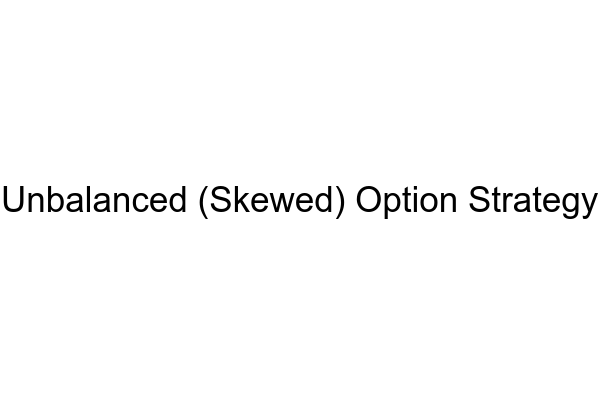Unbalanced (Skewed) Option Strategy

What are the characteristics of this option strategy?
An unbalanced (skewed) option strategy is a strategy that uses different strikes and/or different expirations to take advantage of the unique characteristics of options. This strategy can also involve a combination of puts and calls, as well as different positions in each option and different amounts of capital invested in each position. This means that it is possible to create substantially different payout profiles and risk-reward ratios than those offered by more plain-vanilla options strategies.
Is this a bullish, bearish or neutral strategy?
Unbalanced option strategies can be used both to go long and short, meaning they can be used in both bullish and bearish markets, as well as neutral markets. The skewing of the strategy can allow you to take advantage of the unique properties of options to create a strategy that is more tailored to the specific market environment and specific objectives of the trader.
Is this a beginner or an advanced option strategy?
Unbalanced option strategies require an intermediate understanding of options and an understanding of how different features of options can be used to your advantage. However, the principles of this strategy are relatively straightforward and can be mastered with some practice. As such, these strategies can be used by both beginners and more experienced option traders alike.
In what situation will I use this strategy?
Unbalanced option strategies are typically used in more volatile markets, as the skewing of the strategy will often be more pronounced when volatility is higher. This means that these strategies are best suited for markets that see larger price swings and have a higher potential for quick profits.
Where does this strategy typically fall in the range of risk-reward and probability of profit?
Unbalanced option strategies can offer a wide range of risk-reward ratios and have a higher potential for profits than more traditional options strategies. The risk-reward ratio will depend on the specifics of the strategy, but unbalanced strategies typically have a higher reward and a higher probability of profit than more traditional strategies.
How is this strategy affected by the greeks?
The greeks are important factors to consider when using any options trading strategy. When using unbalanced option strategies, one should pay particular attention to the effects of delta, vega, gamma and theta, as these greeks will be more likely to influence the outcome of the strategy than when using more traditional strategies.
In what volatility regime (i.e VIX level) would this strategy be optimal?
Unbalanced option strategies are best used in high volatility environments, as they tend to be more profitable in such volatile markets. Ideally, a trader would use these strategies when the VIX is near historical highs, as this is when these strategies can be most profitable.
How do I adjust this strategy when the trade goes against me? And how easy or difficult is this strategy to adjust?
The adjustment of an unbalanced option strategy can be both simple and complex, depending on the specifics of the strategy. Generally speaking, it is relatively simple to adjust these strategies as long as they are monitored closely and adjustments are made quickly. However, more complex strategies may require more in-depth knowledge and experience to make profitable adjustments.
Where does this strategy typically fall in the range of commissions and fees?
Unbalanced option strategies tend to have higher commission costs than more traditional options strategies, as these strategies often involve more complex trades and more individual trades. However, due to the potential for higher profits, the commissions can be offset by the gains of the strategy.
Is this a good option income strategy?
Unbalanced option strategies are well suited for option income strategies as they tend to provide higher potential returns than more traditional options strategies. These strategies can be used to generate income while also limiting risk, making them a good choice for traders looking to increase their overall returns.
How do I know when to exit this strategy?
The timing of when to exit an unbalanced option strategy can vary due to the unique characteristics of the strategy. Generally speaking, these strategies should be exited when the potential reward is lower than the potential risk, or when the market environment has changed and the strategy no longer offers an advantage.
How will market makers respond to this trade being opened?
Market makers may respond differently to unbalanced option strategies, depending on the specifics of the strategy and the current market conditions. Generally speaking, these strategies are likely to attract more attention from market makers than more plain-vanilla options strategies.
What is an example (with calculations) of this strategy?
An example of an unbalanced option strategy is a strangle, which involves going long a call and put option with different strikes. For example, if XYZ stock is currently trading at $100, a trader may buy a $105 call and a $95 put, with the same expiration. This trade is unbalanced because it involves buying different strikes and could potentially yield a higher profit if XYZ moves significantly in either direction, while also limiting losses if XYZ moves in the opposite direction.
MarketXLS
MarketXLS is a financial analysis suite that provides powerful option analytics and trading capabilities. With MarketXLS, you can customize and analyze unbalanced options strategies, including creating sophisticated strangles and other complex strategies. MarketXLS also provides advanced analytics to help you identify optimal trading opportunities and maximize profits.
Here are some templates that you can use to create your own models
Search for all Templates here: https://marketxls.com/templates/
